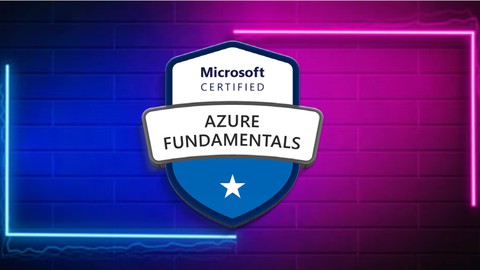Microsoft Azure Fundamentals AZ-900 – Practice Test

Description
Exam AZ-900: Microsoft Azure Fundamentals checks and validates your fundamental knowledge of cloud services and how Microsoft Azure provides the cloud services, irrespective of any specific role.
Microsoft AZ-900 Exam Syllabus Topics:
Describe Cloud Concepts (20-25%)
Identify the benefits and considerations of using cloud services
– identify the benefits of cloud computing, such as High Availability, Scalability, Elasticity, Agility, and Disaster Recovery
– identify the differences between Capital Expenditure (CapEx) and Operational Expenditure (OpEx)
– describe the consumption-based model
Describe the differences between categories of cloud services
– describe the shared responsibility model
– describe Infrastructure-as-a-Service (IaaS)
– describe Platform-as-a-Service (PaaS)
– describe serverless computing
– describe Software-as-a-Service (SaaS)
– identify a service type based on a use case
Describe the differences between types of cloud computing
– define cloud computing
– describe Public cloud
– describe Private cloud
– describe Hybrid cloud
– compare and contrast the three types of cloud computing
Describe Core Azure Services (15-20%)
Describe the core Azure architectural components
– describe the benefits and usage of Regions and Region Pairs
– describe the benefits and usage of Availability Zones
– describe the benefits and usage of Resource Groups
– describe the benefits and usage of Subscriptions
– describe the benefits and usage of Management Groups
– describe the benefits and usage of Azure Resource Manager
– explain Azure resources
Describe core resources available in Azure
– describe the benefits and usage of Virtual Machines, Azure App Services, Azure Container Instances (ACI), Azure Kubernetes Service (AKS), and Azure Virtual Desktop
– describe the benefits and usage of Virtual Networks, VPN Gateway, Virtual Network peering, and ExpressRoute
– describe the benefits and usage of Container (Blob) Storage, Disk Storage, File Storage, and storage tiers
– describe the benefits and usage of Cosmos DB, Azure SQL Database, Azure Database for MySQL, Azure Database for PostgreSQL, and SQL Managed Instance
– describe the benefits and usage of Azure Marketplace
Describe core solutions and management tools on Azure (10-15%)
Describe core solutions available in Azure
– describe the benefits and usage of Internet of Things (IoT) Hub, IoT Central, and Azure Sphere
– describe the benefits and usage of Azure Synapse Analytics, HDInsight, and Azure Databricks
– describe the benefits and usage of Azure Machine Learning, Cognitive Services and Azure Bot Service
– describe the benefits and usage of serverless computing solutions that include Azure Functions and Logic Apps
– describe the benefits and usage of Azure DevOps, GitHub, GitHub Actions, and Azure DevTest Labs
Describe Azure management tools
– describe the functionality and usage of the Azure Portal, Azure PowerShell, Azure CLI, Cloud Shell, and Azure Mobile App
– describe the functionality and usage of Azure Advisor
– describe the functionality and usage of Azure Resource Manager (ARM) templates
– describe the functionality and usage of Azure Monitor
– describe the functionality and usage of Azure Service Health
Describe general security and network security features (10-15%)
Describe Azure security features
– describe basic features of Azure Security Center, including policy compliance, security alerts, secure score, and resource hygiene
– describe the functionality and usage of Key Vault
– describe the functionality and usage of Azure Sentinel
– describe the functionality and usage of Azure Dedicated Hosts
Describe Azure network security
– describe the concept of defense in depth
– describe the functionality and usage of Network Security Groups (NSG)
– describe the functionality and usage of Azure Firewall
– describe the functionality and usage of Azure DDoS protection
Describe identity, governance, privacy, and compliance features (15-20%)
Describe core Azure identity services
– explain the difference between authentication and authorization
– define Azure Active Directory
– describe the functionality and usage of Azure Active Directory
– describe the functionality and usage of Conditional Access, Multi-Factor Authentication (MFA), and Single Sign-On (SSO)
Describe Azure governance features
– describe the functionality and usage of Role-Based Access Control (RBAC)
– describe the functionality and usage of resource locks
– describe the functionality and usage of tags
– describe the functionality and usage of Azure Policy
– describe the functionality and usage of Azure Blueprints
– describe the Cloud Adoption Framework for Azure
Describe privacy and compliance resources
– describe the Microsoft core tenets of Security, Privacy, and Compliance
– describe the purpose of the Microsoft Privacy Statement, Online Services Terms (OST) and Data Protection Amendment (DPA)
– describe the purpose of the Trust Center
– describe the purpose of the Azure compliance documentation
– describe the purpose of Azure Sovereign Regions (Azure Government cloud services and Azure China cloud services)
Describe Azure cost management and Service Level Agreements (10-15%)
Describe methods for planning and managing costs
– identify factors that can affect costs (resource types, services, locations, ingress and egress traffic)
– identify factors that can reduce costs (reserved instances, reserved capacity, hybrid use benefit, spot pricing)
– describe the functionality and usage of the Pricing calculator and the Total Cost of Ownership (TCO) calculator
– describe the functionality and usage of Azure Cost Management
Describe Azure Service Level Agreements (SLAs) and service lifecycles
– describe the purpose of an Azure Service Level Agreement (SLA)
– identify actions that can impact an SLA (i.e. Availability Zones)
– describe the service lifecycle in Azure (Public Preview and General Availability)
Who this course is for:
- System Administrators
- Developers
- Administrator, Developer and system Architects
- Colleage Students






